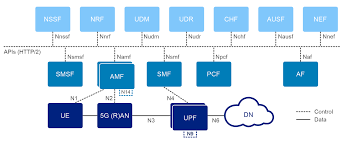5G NR SCG and RLF Failures: Causes, Detection, and Recovery Strategies
telcomatraining.com – The advent of 5G New Radio (NR) has introduced a transformative shift in wireless communication, promising ultra-low latency, high data rates, and massive device connectivity. However, maintaining consistent performance requires the resolution of critical issues such as Secondary Cell Group (SCG) failures and Radio Link Failures (RLF). These failures can significantly impact user experience, especially in Non-Standalone (NSA) 5G deployments, where 5G NR operates in conjunction with LTE.
In this article, we’ll explore the primary causes of SCG and RLF failures in 5G NR, how they can be effectively detected, and what strategies can be implemented for quick recovery.
What are SCG and RLF Failures?
In 5G NR NSA architecture, the Secondary Cell Group (SCG) comprises the 5G component that operates alongside the LTE master node. A failure in the SCG refers to a disruption in the 5G link while the LTE anchor remains active. On the other hand, Radio Link Failure (RLF) indicates a breakdown in the radio connection due to poor signal quality, leading to dropped connections or handover issues.
Both SCG and RLF events are monitored and managed by the base station (gNB) and the User Equipment (UE) to ensure seamless connectivity and Quality of Service (QoS).
Causes of SCG and RLF Failures
Understanding the root causes of these failures is essential for effective mitigation. Common triggers include:
- Poor Signal Quality: High interference, low signal-to-noise ratio (SNR), and weak signal strength in the SCG can lead to connection loss.
- Mobility Issues: Fast-moving UEs often cross cell boundaries rapidly, leading to incomplete or delayed handover processes.
- Interference and Network Congestion: Increased user density or interference from neighboring cells can cause degradation in the SCG link.
- Incorrect Configuration: Mismatches in radio parameters between LTE and 5G nodes may result in failed signaling or incorrect handovers.
- Hardware and Software Malfunctions: Faults in UE or base station hardware/software can disrupt link establishment and maintenance.
Detection of SCG and RLF Failures
Early detection of SCG and RLF failures is key to minimizing their impact. Detection mechanisms include:
- RRC Layer Monitoring: The Radio Resource Control (RRC) layer monitors link status and triggers reconfiguration or recovery procedures when thresholds are breached.
- Event-Based Reporting: UEs report specific measurement events (e.g., A3, A5, B1) indicating deterioration in signal conditions.
- gNB Logging and KPIs: Base stations use key performance indicators (KPIs) such as handover success rates, SCG addition failures, and RLF counters to monitor performance.
- UE Measurement Reports: Real-time feedback from UEs can indicate declining link quality or impending failure.
Recovery Strategies for 5G NR Failures
Quick recovery from SCG and RLF failures is critical to maintaining service continuity. Effective strategies include:
- SCG Reconfiguration: Automatically removing and re-adding the SCG component allows the system to recover from temporary radio anomalies.
- Fallback to LTE (RRC Re-establishment): If the 5G NR link fails, the UE may fall back to LTE, using it as a fallback anchor to maintain connectivity.
- Mobility Enhancements: Improved handover algorithms and dynamic resource allocation can reduce mobility-induced failures.
- Redundancy and Load Balancing: Using multiple 5G nodes or balancing the load across cells helps prevent congestion-based failures.
- AI-based Predictive Maintenance: Machine learning algorithms can predict failure trends and trigger preemptive actions.
Conclusion
5G NR SCG and RLF failures represent critical challenges in maintaining robust and seamless connectivity in next-generation mobile networks. By identifying the root causes, implementing real-time detection mechanisms, and deploying intelligent recovery strategies, operators can ensure high-quality user experiences and network reliability. As 5G continues to evolve, proactive network management will become increasingly vital in minimizing disruptions and unlocking the full potential of advanced wireless technologies.







